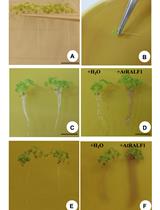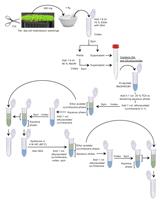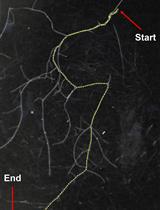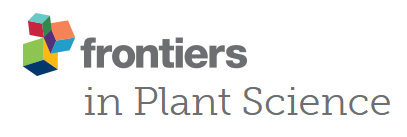- Submit a Protocol
- Receive Our Alerts
- Log in
- /
- Sign up
- My Bio Page
- Edit My Profile
- Change Password
- Log Out
- EN
- EN - English
- CN - 中文
- Protocols
- Articles and Issues
- For Authors
- About
- Become a Reviewer
- EN - English
- CN - 中文
- Home
- Protocols
- Articles and Issues
- For Authors
- About
- Become a Reviewer
Extraction and Quantification of Plant Hormones and RNA from Pea Axillary Buds
Published: Vol 12, Iss 19, Oct 5, 2022 DOI: 10.21769/BioProtoc.4524 Views: 2856
Reviewed by: Ansul LokdarshiAnonymous reviewer(s)

Protocol Collections
Comprehensive collections of detailed, peer-reviewed protocols focusing on specific topics
Related protocols

Evaluation of Root pH Change Through Gel Containing pH-sensitive Indicator Bromocresol Purple
Aparecida L. Silva [...] Daniel S. Moura
Apr 5, 2018 9929 Views

Quantification of Salicylic Acid (SA) and SA-glucosides in Arabidopsis thaliana
Valérie Allasia [...] Harald Keller
May 20, 2018 13055 Views

I Plate-based Assay for Studying How Fungal Volatile Compounds (VCs) Affect Plant Growth and Development and the Identification of VCs via SPME-GC-MS
Wenzhao Wang [...] Seogchan Kang
Feb 20, 2019 8168 Views
Abstract
The quantification of plant hormones and related gene expression is essential to improve the understanding of the molecular regulation of plant growth and development. However, plant hormone quantification is still challenging due to extremely low endogenous levels and high chemical diversity. In this study, we present a convenient extraction protocol that enables the simultaneous extraction of both phytohormones and RNA from the same sample in a small quantity (approximately 10 mg). Using ultra-performance liquid chromatography coupled with tandem mass spectrometry (UPLC–MS/MS), this protocol provides a method to quantify 13 phytohormones and their derivatives from four classes (cytokinin, auxin, abscisic acid, and gibberellin) at the speed of 14 min per sample.
Keywords: Phytohormone and RNA extractionBackground
Phytohormones are endogenous signaling molecules that are involved in an immensely diverse range of plant physiological and developmental processes, which makes them critical for plant growth, development, and responses to biotic and abiotic stresses. Axillary bud outgrowth is a perfect example of a developmental process involving multiple phytohormones. Auxin, cytokinin, and strigolactone have been found to play major roles in triggering axillary bud dormancy (Barbier et al., 2019b). Abscisic acid and gibberellic acid are also involved in axillary bud outgrowth regulation (Yao and Finlayson, 2015; Charnikhova et al., 2017).
Despite their importance for plant growth regulation, not all phytohormones can yet be easily detected and quantified, which significantly limits the progression of phytohormone-related research (Cao et al., 2017; Liu et al., 2019). Due to various chemical classes and ultra-trace amounts of phytohormones in plant tissues, it is also difficult to measure a variety of phytohormone classes using a single separation method and analytical platform (Novák et al., 2017). Moreover, phytohormone levels vary between different plant tissues (Novák et al., 2017). Thus, it is important to select appropriate pre-treatment and quantification methods to boost the measurement sensitivity of targeted phytohormones (Yu et al., 2018). Ultra-performance liquid chromatography coupled with tandem mass spectrometry (UPLC–MS/MS) has become the most efficient method for boosting measurement sensitivity, as it provides high selectivity and sensitivity for phytohormone profiling (Pan et al., 2010; Schäfer et al., 2016; Šimura et al., 2018). However, mass spectrometry sensitivity is strongly influenced by other compounds in plant materials, which suppress the ionization of target compounds (Trapp et al., 2014). Thus, a specific cleanup extraction method for phytohormones is needed. To quantify multiple phytohormone classes, many studies have used a time-consuming parallel extraction method for different classes of phytohormones (Cao et al., 2016; Xin et al., 2020). In addition to phytohormone profiling, monitoring gene expression is a key requirement for understanding the involvement of phytohormones in plant physiology and development (Šimura et al., 2018; Barbier et al., 2019b). However, a simultaneous extraction method for a wide range of phytohormones and RNA using one simple extraction method had not been previously reported.
Materials and Reagents
Phytohormone standards and internal standards (Table 1).
Table 1. Phytohormone standards and internal standards.
Reagent Supplier Classification Catalog number Storage temperature (°C) tZEATIN OlChemim STD 001 0301 -20 DHZ OlChemim STD 001 0601 -20 tZR OlChemim STD 001 0311 -20 DHZR OlChemim STD 001 0611 -20 tZMP OlChemim STD 001 5141 -20 iP OlChemim STD 001 0161 -20 iPR OlChemim STD 001 0171 -20 iPAMP OlChemim STD 001 5041 -20 IAA OlChemim STD 003 1531 -20 GA1 OlChemim STD 012 2491 -20 ABA OlChemim STD 013 2701 -20 D5-tZ OlChemim ISTD 030 0301 -20 D3-DZ OlChemim ISTD 030 0601 -20 d5-tZR OlChemim ISTD 030 0311 -20 d3-DZR OlChemim ISTD 030 0611 -20 d5-tZRP OlChemim ISTD 030 0311 -20 d6-iP OlChemim ISTD 030 0161 -20 d6-iPR OlChemim ISTD 030 0171 -20 d6-iPAMP OlChemim ISTD 030 5041 -20 d5-IAA OlChemim ISTD 031 1531 -20 d2-GA1* OlChemim ISTD 032 2491 -20 d2-GA20 OlChemim ISTD 032 2481 -20 d2-GA29 OlChemim ISTD 032 2471 -20 d6-ABA OlChemim ISTD 034 2721 -20 Tzeatin: trans-zeatin; DHZ: dihydrozeatin; tZR: trans-zeatin riboside; DHZR: dihydrozeatin ribodide; tZMP: trans-zeatin riboside-5'-monophosphate; iP: isopentenyladenine; iPR: isopentenyladenosine; iPAMP: isopentenyladenosine-5'-monophosphate; IAA: indole-3-acetic acid; ABA: abscisic acid; GA1, 20, and 29: gibberellin A1, A20, and A29; STD: phytohormone standard; ISTD: phytohormone internal standard.
*Can be replaced with d4-GA1 (product number: 032 2491) due to d2-GA1 not being commercially available anymore.
Acetonitrile (Merck, catalog number: 1.00030)
Methanol (Merck, catalog number: 1.06007)
Milli-Q water (Merk Milli-Q)
Acetic acid (Merck, catalog number: 5.33001)
Formic acid (Merck, catalog number: 5.33002)
Liquid nitrogen
Node 2 axillary buds from garden pea plants with five fully expanded leaves
Internal standard working solution (see Recipes)
Extraction solvent (see Recipes)
1% acetic acid (see Recipes)
Plant hormone standard solutions (see Recipes)
Equipment
2010 Geno Grinder (SPEX SamplePrep, model: 2010)
3 mm diameter 440C stainless steel balls for Geno/Grinder 2010 (SPEX SamplePrep, product number: 2151)
Refrigerated centrifuge (Eppendorf, model: 5425R)
Solid phase extraction manifold (Chromabond, model: 730150)
Rotational vacuum concentrator with cold trap (Christ, model: RVC 2-33)
Ultra-high pressure liquid chromatograph system (Shimadzu Corporation, model: Nexera X2)
Triple quadrupole linear ion trap mass spectrometry system (AB Sciex, model: 5500)
Laboratory scale (accuracy: 0.0001 g)
Sep-Pak tC18 cartridge (Waters, catalog number: WAT036820)
1.5 mL Eppendorf tube (Eppendorf, catalog number: 0030121872)
HPLC vial (Agilent, catalog number: 5188-6591)
HPLC cap (Agilent, catalog number: 5190-7024)
Kinetex C18 reversed phase UPLC column (2.1 mm ×100 mm, 1.7 μm) (Phenomenex, catalog number: 00A-4475-AN)
Vertex low-retention non-filtered pipette tip (SSIbio, catalog number: 4337N00)
15 mL Falcon tube (Corning, catalog number: 352096)
4 °C refrigerator and -20 °C and -80 °C freezer
Procedure
Homogenization and extraction of samples
Weigh a 1.5 mL Eppendorf tube with two grinding beads (3 mm stainless steel metal balls) inside.
Sample 20 pea axillary buds (approximately 2 mm each) into one Eppendorf tube and snap freeze in liquid nitrogen.
Weigh the Eppendorf tube again after sampling and calculate the weight of axillary buds.
Homogenize the frozen plant tissues with 2010 Geno Grinder at 4 °C (1,500 stroke/min, 2×1 min).
Two outputs: RNA pellet and supernatant
Add 1 mL of freshly prepared extraction solvent (80% acetonitrile containing 1% acetic acid and 5 µL internal standard working solution) to the homogenized sample and vortex for 10 s at room temperature.
Leave the extract at -20 °C for 5 min and then centrifuge at 15,900 × g and 4 °C for 10 min.
Transfer 950 μL of supernatant to a new Eppendorf tube for hormone extraction. The remaining pellet can be used for RNA extraction (see Note 1).
Evaporate supernatant using a rotational vacuum concentrator with cold trap at room temperature until pellet is completely dry.
Sample cleaning with solid phase extraction (SPE) column
Add 1 mL of 1% acetic acid to the dried sample and pipette up and down three times for redissolution.
Store the sample at 4 °C until loading on Sep-Pak tC18 cartridge at step 14.
Set up the solid phase extraction manifold with Sep-Pak tC18 cartridge (Figure 1).

Figure 1. The setup of solid phase extraction manifold with Sep-Pak tC18 cartridge.Wash Sep-Pak tC18 cartridge with 1 mL of 100% methanol.
Activate tC18 cartridge with 1 mL of 1% acetic acid.
Load the sample (from step 10) on the activated cartridge.
Wash the loaded cartridge with 1 mL of 1% acetic acid.
Elute the sample with 1 mL of 80% acetonitrile containing 1% acetic acid.
Evaporate the eluted sample using the rotational vacuum concentrator with cold trap at room temperature until completely dry.
Add 50 µL of 1% acetic acid to the dried sample, pipette up and down three times for redissolution, and vortex for 30 s.
Centrifuge the dissolved sample at 15,900 × g and 4 °C for 10 min and transfer the supernatant into a HPLC vial.
Store the sample at -80 °C before loading on the UPLC–MS/MS.
UPLC–MS/MS setup
The UPLC–MS/MS system used for this protocol is a Nexera X2 ultra-high pressure liquid chromatograph system coupled with a 5500 triple quadrupole linear ion trap mass spectrometry system equipped with an electrospray ionization source (ESI). The UPLC method is as follows:
Mobile phase A: 0.5% formic acid in Milli-Q water (v/v).
Mobile phase B: 0.5% formic acid in acetonitrile (v/v).
Flow rate: 0.5 mL min-1.
UPLC gradient: 4% B over 0.5 min, 4%–15% B over 7 min, and 15%–95% B over 3.5 min.
Cleanup step: 95%–95% B over 2 min, 95%–4% B over 0.1 min, and column wash for 1 min.
ESI parameters (for positive and negative modes, respectively): curtain gas, 20 psi; collision gas, medium; ion source temperature, 500 °C; ion source gas 1 and 2, 80 psi; and IonSpary voltage, +4,500 V or -4,500 V.
The scheduled multiple reaction monitoring (sMRM) parameters are listed in Table 2.
Table 2. sMRM parameters for phytohormone standards and their corresponding internal standards. CE, DP, and EP are the same between PH and ISTD.
| PH | Q1 | Q3 | RT | SM | ISTD | Q1 | Q3 | RT | SM | CE | DP | EP |
|---|---|---|---|---|---|---|---|---|---|---|---|---|
| tZEATIN | 220 | 136 | 2.3 | + | d5-tZ | 225 | 136 | 2.2 | + | 25 | 75 | 10 |
| DHZ | 222 | 136 | 2.5 | + | d3-DZ | 225 | 136 | 2.4 | + | 25 | 100 | 8 |
| tZR | 352 | 220 | 3.5 | + | d5-tZR | 357 | 225 | 3.3 | + | 25 | 80 | 10 |
| DHZR | 354 | 222 | 3.6 | + | d3-DZR | 357 | 225 | 3.4 | + | 30 | 80 | 10 |
| tZMP | 432 | 220 | 1.9 | + | d5-tZRP | 437 | 225 | 1.8 | + | 25 | 100 | 10 |
| IP | 204 | 136 | 5.4 | + | d6-IP | 210 | 136 | 5 | + | 20 | 70 | 10 |
| IPR | 336 | 136 | 6.9 | + | d6-IPR | 342 | 136 | 6.5 | + | 40 | 80 | 10 |
| IPAMP | 416 | 136 | 4 | + | d6-IPRP | 422 | 136 | 3.5 | + | 42 | 100 | 10 |
| IAA | 176 | 130 | 8.1 | + | d5-IAA | 181 | 135 | 8.1 | + | 25 | 120 | 15 |
| GA1 | 347 | 229 | 7.6 | - | d2-GA1 | 349 | 231 | 7.6 | - | -40 | -80 | -15 |
| GA20 | 331 | 287 | 9.5 | - | d2-GA20 | 333 | 289 | 9.5 | - | -30 | -80 | -15 |
| GA29 | 347 | 303 | 4.8 | - | d2-GA29 | 349 | 305 | 4.8 | - | -30 | -80 | -15 |
| ABA | 263 | 153 | 9.4 | - | d6-ABA | 269 | 159 | 9.4 | - | -20 | -80 | -15 |
PH: phytohormone; Q1: precursor ion selected in Q1; Q3: product ion selected in Q3; RT: retention time; ISTD: internal standard; SM: scan mode; CE: collision energy; DP: declustering potential; EP: entrance potential.
Data analysis
MultiQuant software (AB Sciex, USA) is used to analyze raw mass spectrometry data. The concentration of each hormone is further calculated using Microsoft Excel by comparing with the internal standard concentration added in the sample.
Notes
The RNA from the plant debris pellet should be able to be extracted using most available RNA extraction methods. Two established RNA extraction methods have been tested: the first is a commercial RNA extraction kit, and the second is a cetyltrimethylammonium bromide (CTAB)-based method (Barbier et al., 2019a; Cao et al., 2020). The RNA from the pellet is extracted immediately, and the preservation condition for the pellet has not been tested in this protocol.
The validation of the UPLC–MS/MS method has been detailed in our previous publication (Cao et al., 2020).
Plant material should always be kept frozen until adding the extraction solvent, to prevent degradation of plant hormones or possible metabolic reactions in the plant cell.
Sep-Pak tC18 cartridge should be kept wet after activation until the elution of the sample.
The maintenance of the UPLC–MS/MS system should be strictly followed as per the requirement of the manufacturer, to prevent sensitivity decrease and environmental contamination.
All solvents and consumables that directly contact the sample have been tested and are free of environmental contamination. If any consumables need to be replaced with different brands, environmental contamination needs to be tested.
If the UPLC–MS/MS system needs to be replaced with other types of models or brands (e.g., Agilent, Thermos, or Waters), the settings of the UPLC–MS/MS need to be reoptimized with plant hormone standards and internal standards.
If the plant hormone extraction process cannot be finished in one working day, the process can be paused after step 8, and the dried sample can be stored at -20 °C for 24 h before continuing the extraction.
A summarized flow chart for the phytohormone and RNA extraction can be found at https://www.frontiersin.org/files/Articles/605069/fpls-11-605069-HTML/image_m/fpls-11-605069-g001.jpg.
Recipes
Internal standard working solution
10 ng mL-1 d5-tZEATIN
20 ng mL-1 d3-DHZ
40 ng mL-1 d5-tZR
100 ng mL-1 d3-DHZR
120 ng mL-1 d5-tZMP
40 ng mL-1 d6-iP
60 ng mL-1 d6-iPA
10 ng mL-1 d6-iPRMP
200 ng mL-1 d5-IAA
200 ng mL-1 d2-GA20
200 ng mL-1 d2-GA29
200 ng mL-1 d6-ABA
Dissolved in 100% methanol.
Store at -80 °C for up to one month.
Extraction solvent
Dilute acetonitrile and acetic acid with Milli-Q water, to 80% acetonitrile containing 1% acetic acid. Store at 4 °C for up to one month.
1% acetic acid
Dilute acetic acid with Milli-Q water to 1% acetic acid. Store at 4 °C for up to one month.
Plant hormone standard solutions
Plant hormone standard and internal standard solutions were diluted with methanol to 100 µg mL-1 (stock solution) and 1 µg mL-1 (working solution). Store at -80 °C for up to one year.
Acknowledgments
This method has been published as a methodology article in Frontiers of Plant Science (Cao et al., 2020). This research was funded by The University of Queensland and the Australian Research Council Georgina Sweet Fellowship (FL180100139) and supported during the establishment phase of the ARC Centre of Excellence for Plant Success in Nature and Agriculture (CE200100015). We thank Dr. Lindsay Shaw for reviewing the manuscript.
Competing interests
The authors declare that the research was conducted in the absence of any commercial or financial relationships that could be construed as a potential conflict of interest.
References
- Barbier, F. F., Chabikwa, T. G., Ahsan, M. U., Cook, S. E., Powell, R., Tanurdzic, M. and Beveridge, C. (2019a). A phenol/chloroform-free method to extract nucleic acids from recalcitrant, woody tropical species for gene expression and sequencing. Plant Methods 15(1): 62.
- Barbier, F. F., Dun, E. A., Kerr, S. C., Chabikwa, T. G. and Beveridge, C. A. (2019b). An update on the signals controlling shoot branching. Trends Plant Sci 24(3): 220-236.
- Cao, D., Barbier, F., Yoneyama, K. and Beveridge, C. A. (2020). A rapid method for quantifying RNA and phytohormones from a small amount of plant tissue. Front Plant Sci 11(1832).
- Cao, D., Lutz, A., Hill, C. B., Callahan, D. L. and Roessner, U. (2017). A quantitative profiling method of phytohormones and other metabolites applied to barley roots subjected to salinity stress. Front Plant Sci 7: 2070.
- Cao, Z.-Y., Sun, L. H., Mou, R. X., Zhang, L. P., Lin, X. Y., Zhu, Z. W. and Chen, M. X. (2016). Profiling of phytohormones and their major metabolites in rice using binary solid-phase extraction and liquid chromatography-triple quadrupole mass spectrometry. J Chromatogr A 1451: 67-74.
- Charnikhova, T. V., Gaus, K., Lumbroso, A., Sanders, M., Vincken, J. P., De Mesmaeker, A., Ruyter-Spira, C. P., Screpanti, C. and Bouwmeester, H. J. (2017). Zealactones. Novel natural strigolactones from maize. Phytochemistry 137: 123-131.
- Liu, Y., Fang, X. a., Chen, G., Ye, Y., Xu, J., Ouyang, G. and Zhu, F. (2019). Recent development in sample preparation techniques for plant hormone analysis. TrAC Trends in Analyt Chem 113: 224-233.
- Novák, O., Napier, R. and Ljung, K. (2017). Zooming in on plant hormone analysis: tissue-and cell-specific approaches. Annu Rev Plant Biol 68: 323-348.
- Pan, X., Welti, R. and Wang, X. (2010). Quantitative analysis of major plant hormones in crude plant extracts by high-performance liquid chromatography–mass spectrometry. Nat Protoc 5(6): 986.
- Schäfer, M., Brütting, C., Baldwin, I. T. and Kallenbach, M. (2016). High-throughput quantification of more than 100 primary-and secondary-metabolites, and phytohormones by a single solid-phase extraction based sample preparation with analysis by UHPLC–HESI–MS/MS. Plant Methods 12(1): 30.
- Šimura, J., Antoniadi, I., Široká, J., Tarkowská, D., Strnad, M., Ljung, K. and Novák, O. (2018). Plant hormonomics: Multiple phytohormone profiling by targeted metabolomics. Plant Physiol 177(2): 476-489.
- Trapp, M. A., De Souza, G. D., Rodrigues-Filho, E., Boland, W. and Mithöfer, A. (2014). Validated method for phytohormone quantification in plants. Front Plant Sci 5(1-11).
- Xin, P., Guo, Q., Li, B., Cheng, S., Yan, J. and Chu, J. (2020). A Tailored High-efficiency Sample Pretreatment Method for Simultaneous Quantification of 10 Classes of Known Endogenous Phytohormones. Plant Commun 1(3): 100047.
- Yao, C. and Finlayson, S. (2015). Abscisic acid is a general negative regulator of Arabidopsis axillary bud growth. Plant Physiol 169(1): 611-626.
- Yu, D., Rupasinghe, T. W., Boughton, B. A., Natera, S. H., Hill, C. B., Tarazona, P., Feussner, I. and Roessner, U. (2018). A high-resolution HPLC-QqTOF platform using parallel reaction monitoring for in-depth lipid discovery and rapid profiling. Anal Chim Acta 1026: 87-100.
Article Information
Copyright
© 2022 The Authors; exclusive licensee Bio-protocol LLC.
How to cite
Cao, D., Barbier, F., Yoneyama, K. and Beveridge, C. A. (2022). Extraction and Quantification of Plant Hormones and RNA from Pea Axillary Buds. Bio-protocol 12(19): e4524. DOI: 10.21769/BioProtoc.4524.
Category
Plant Science > Plant biochemistry > Plant hormone
Biochemistry > Other compound > Small molecular
Molecular Biology > RNA > qRT-PCR
Do you have any questions about this protocol?
Post your question to gather feedback from the community. We will also invite the authors of this article to respond.
Share
Bluesky
X
Copy link










